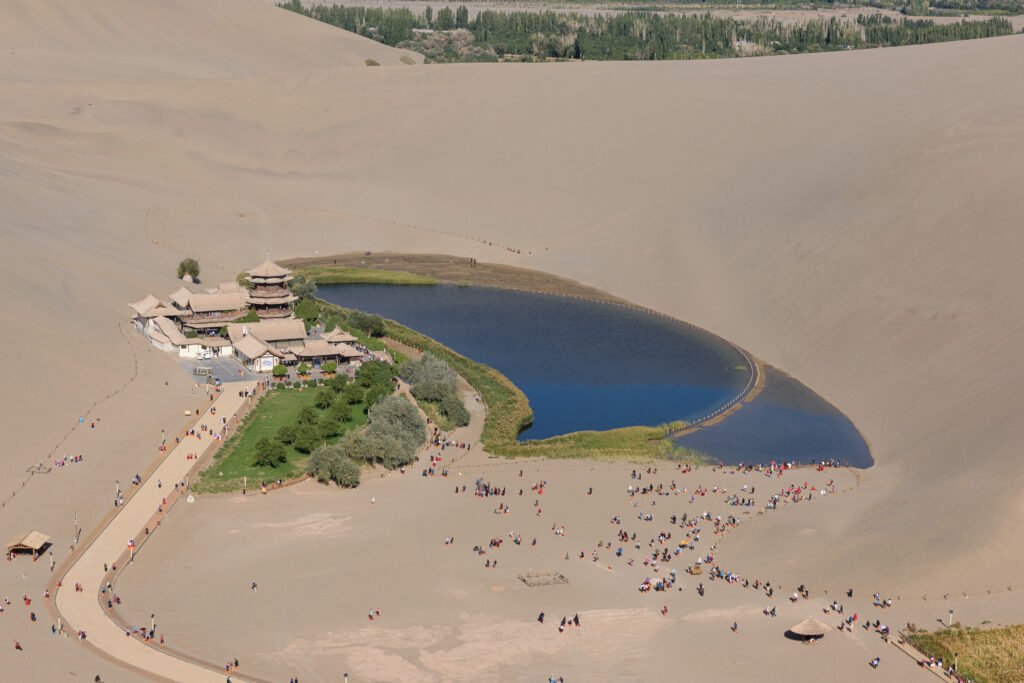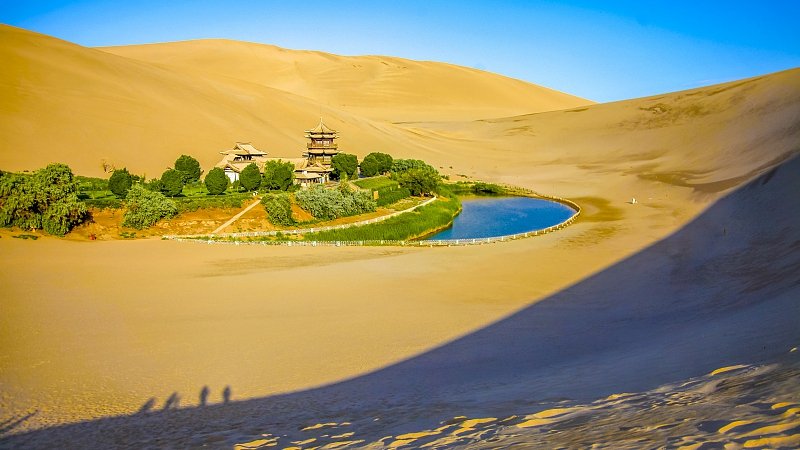The Moon Lake: A Hidden Oasis in the Gobi Desert, China
In the heart of China’s Gobi Desert, surrounded by vast stretches of sand dunes, lies an unexpected natural wonder: The Moon Lake, also known as Yueyaquan. This crescent-shaped oasis has been a key landmark for centuries, serving as a vital stop for travelers along the ancient Silk Road. Despite its location in one of the most arid regions in the world, the lake remains surprisingly vibrant, sustained by a mix of natural groundwater and modern conservation efforts.
The Moon Lake’s stunning beauty, historical significance, and environmental resilience make it a must-visit destination for nature lovers and history enthusiasts alike. Let’s dive into the fascinating story behind this oasis in the desert.
The Geography and Formation of Yueyaquan
Moon Lake, or Yueyaquan, is renowned for its unique crescent shape, which gives the impression of a glowing moon nestled in the sands. Located near Dunhuang, a city in the Gansu Province of China, the lake sits at the foot of the Mingsha Mountains, where the shifting sand dunes of the desert create a surreal landscape. The lake is approximately 218 meters (717 feet) long, 24 meters (79 feet) wide, and 1.5 meters (5 feet) deep, making it an enchanting sight in the otherwise barren surroundings.
The lake’s unique shape and position make it look almost otherworldly, with its clear blue waters providing a stark contrast to the golden dunes that surround it. Over centuries, this crescent-shaped oasis has drawn attention, both as a vital water source for travelers and as a subject of curiosity due to its location in an unforgiving desert environment.

Historical Significance of the Moon Lake
Moon Lake has played an important role in the region for centuries. Situated along the ancient Silk Road, it provided much-needed water and rest for merchants and travelers journeying across the harsh desert landscape. The lake served as a crucial stop for caravans, offering a place for people and animals to drink, and helping to sustain trade between the east and west.
The oasis is also home to many cultural relics and historical sites, including the famous Dunhuang Caves (Mogao Caves), located nearby. These caves, known for their stunning Buddhist murals and sculptures, are a testament to the cultural and spiritual significance of the region.
In addition, the lake is believed to have been a sacred site for travelers along the Silk Road. Its role as a life-giving oasis in the middle of the desert made it a symbol of hope and endurance for those crossing the Gobi Desert’s vast expanse.
The Ecology and Sustainability of Yueyaquan
Despite the harsh desert environment, Moon Lake has been able to survive thanks to underground springs that feed it. These natural water sources are part of a complex underground water system that helps sustain the lake even during periods of drought.
In recent years, the lake has also benefited from modern conservation efforts. The local government has implemented various measures to prevent the lake from drying up, such as protecting the surrounding area from excessive tourism and controlling the water levels. The careful balance of natural and human-driven preservation ensures that the lake continues to flourish despite the surrounding arid conditions.
This oasis, with its blend of natural beauty and modern conservation, serves as an example of how man and nature can work together to protect precious natural resources.

Why Visit the Moon Lake?
For anyone visiting China, Yueyaquan offers a unique and captivating experience. Here’s why this oasis should be on your travel list:
- Stunning Natural Beauty: The contrast between the blue waters of Moon Lake and the golden sand dunes is simply breathtaking. It’s a photographer’s paradise, with the ever-changing light and shadows creating unique perspectives at every moment of the day.
- Historical and Cultural Significance: As a key stop along the Silk Road, Yueyaquan holds great historical importance. Visitors can learn about its role in facilitating trade and connecting cultures across Asia and Europe. The nearby Dunhuang Caves further enhance the historical appeal of the region.
- Peaceful Oasis in the Desert: The tranquility of the lake, combined with the desert’s quiet expanse, creates a peaceful retreat that allows visitors to reconnect with nature. The atmosphere is both calming and awe-inspiring.
- Unique Desert Ecology: The fact that this oasis exists in such a dry environment is a fascinating testament to the resilience of nature. Visitors can explore how the lake survives thanks to its underground water system, offering insight into the ecological balance of desert environments.
- Adventure and Exploration: For those seeking adventure, the surrounding sand dunes offer opportunities for activities such as camel rides, dune trekking, and sandboarding.
Conclusion
Moon Lake (Yueyaquan) is a true gem hidden within the vast expanse of the Gobi Desert. This crescent-shaped oasis, rich in history and natural beauty, continues to attract visitors from around the world, offering a rare glimpse of life in one of the most extreme environments on Earth. Whether you’re captivated by the lake’s historical significance, fascinated by its unique geography, or simply looking for a tranquil escape in the desert, Yueyaquan is a destination that promises to leave a lasting impression.
